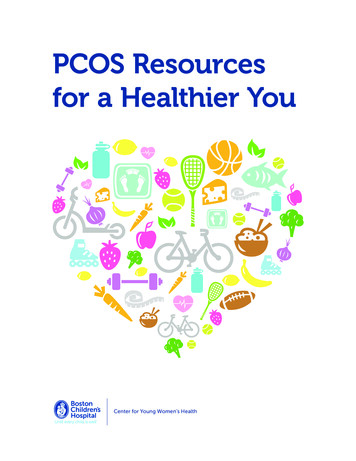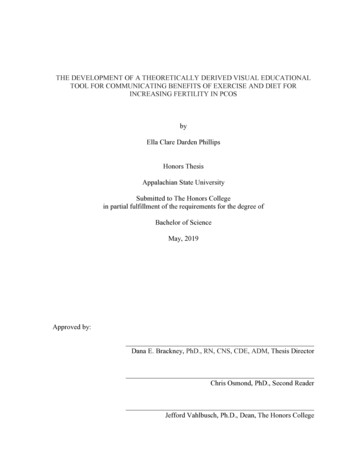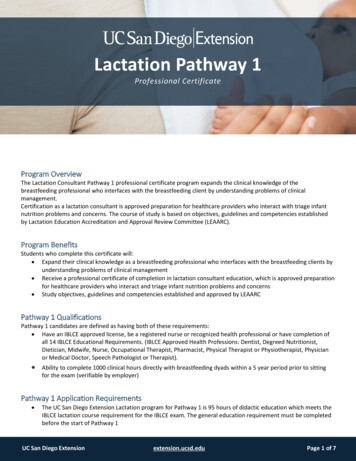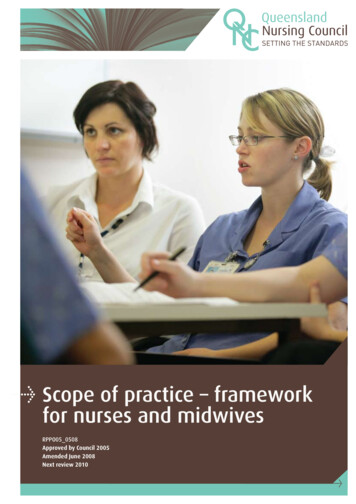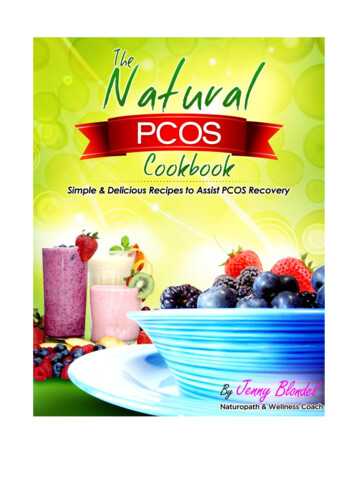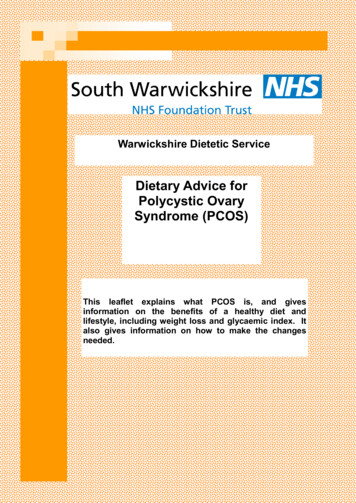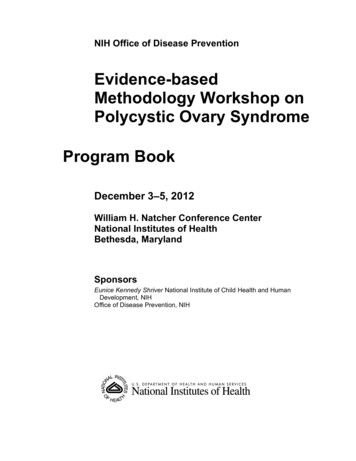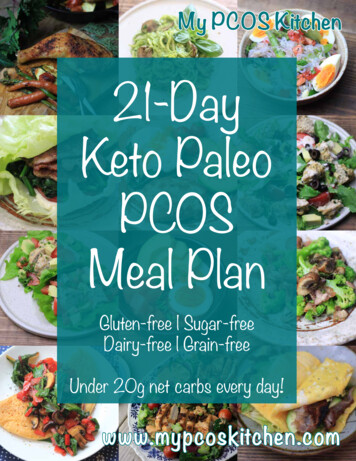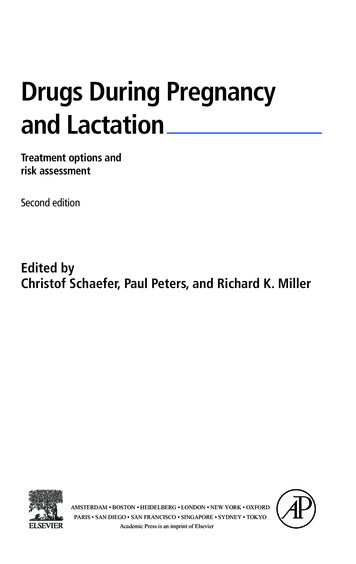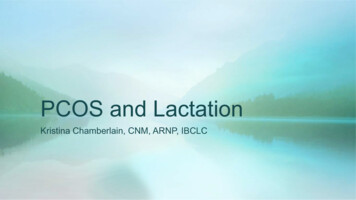
Transcription
PCOS and LactationKristina Chamberlain, CNM, ARNP, IBCLC
Objectives Identify characteristics of Polycystic Ovarian Syndrome (PCOS)based on history, physical exam, and lab results Recognize potential lactation and breastfeeding issues that are aresult of PCOS Knowledge of pharmaceutical and herbal treatments for low milksupply due to PCOS Identify ways to support the lactating mom with PCOS
What is PCOS?Polycystic Ovarian Syndrome
Polycystic Ovarian Syndrome (PCOS) isan endocrine disorder. One of the most frequent reasons womenof childbearing age see gynecologist orother women’s health care provider. No known cause. Possible geneticpredisposition. Affects 10% of women in the US Not all women with PCOS will havelactation issues.What is PCOS?
75-80% of women with PCOS haveirregular cycles– 5-9 cycles/year, length: 40-65 days 60-80% have hirsutism 40-70% have alopecia 40-60% have acne 75% are overweight or obeseThe Stats
To diagnose PCOS, a woman must have 2of the 3 criteria:– Androgen Excess––––Hirsutism, male pattern hair growthAlopeciaIncreased free and total testosteroneAcne– Ovulatory Dysfunction– Amenorrhea– Irregular Cycles– Dysfunctional Uterine Bleeding– Polycystic Ovaries– May not have polycystic ovaries at all!Rotterdam Criteria
There is noovulation withpolycysticovaries.
Hirsutism canalso be onchest,abdomen, andinner thighs.
Obesity Infertility Miscarriage Mood disorders (depression, irritability,tension) Insulin resistance Increase in LH:FSH ratio Increased risk of––––HyperlipidemiaCardiovascular DiseaseType 2 DiabetesGestational DiabetesOther symptoms ofPCOS
HyperactiveProduction ofAndrogensHyperinsulinemia orInsulinResistanceLow levels ofProgesterone Anovulation LH FSH(no maturefollicles)ChronicElevation ofEstrogenCycle of HormonalImbalance
Androgens Hirsutism, Acne,Alopecia LH, FSH, Chronic Estrogen, Progesterone ChronicAnovulation, menstrual irregularities,Infertility, Miscarriage, PolycysticOvaries, Mood Disorders Insulin Resistance abdominal fat(BMI 30), CVD and hyperlipidemiarisk, risk of T2DM and GDMHow does thehormonalimbalance presentitself?
Insulin Resistance and Obesity- affectbreast development in puberty. Insulin Resistance is linked to low milksupply. Preliminary studies show that receptorcells in the breast must remain insulinsensitive to develop properly and functionin response to other lactation hormones.How does PCOSaffect breastdevelopment? Insulin has a direct affect on theproduction of milk, lactogenesis I(secretion of colostrum) and lactogeniesisII (when the milk “comes in”)The Role of Insulin
Type 1 reflects normalbreast development.It isn’t the size of thebreast that indicateshypoplasia. It is theshape, placement, andasymmetry.Huggins, K., Petok, E., Mireles, O.Markers of lactation insufficiency: astudy of 34 mothers. Issues inClinical Lactation. 2000, 25-35
Huggins, K., Petok, E., Mireles, O.Markers of lactation insufficiency: astudy of 34 mothers. Issues inClinical Lactation. 2000, 25-35
History Irregular cycles Overweight, difficulty losing weight (not all women with PCOS areoverweight) Infertility- history of miscarriage or “it took a long time to getpregnant” due to irregular cycles, though may not have usedreproductive technology to get pregnant Acne and hirsutism Blood sugar issues, including GDM No breast changes in pregnancy Previous unsuccessful breastfeeding experience
Physical Exam High BMI (women with BMI 30 are more likely to have milkproduction issues) Note acne, male pattern hair growth Acanthosis Nigricans- can be a marker of pre-diabetes Breasts:–––––Wide spaced apart (more than 1.5 inches apartBreast asymmetry (one breast is significantly larger than the other)Minimal glandular tissue palpated on examTubular breast shapeDisproportionately large areola
Labs to Evaluate LH FSH Estrodial Progesterone- should be checked 7 days after ovulation is believed to haveoccurred Prolactin (non-lactating woman)- high levels can also indicated pituitary tumor Glucose Tolerance Test or Fasting Glucose Test Total and Free Testosterone Thyroid Panel Lipid Profile Pregnancy Test
Breastfeeding Scenario No lactogenesis II- milk doesn’t come in or comes in very late Baby falls asleep at the breast without getting a full “meal” Slow weight gain or weight loss. Doesn’t get to birth weight by 2weeks of age. Poor output. Jaundice The usual treatments to increase milk supply isn’t working.
Case Study #1 33 yo, female, G0 Was dx’d in 2009 with PCOS by another provider via blood tests.Never had a pelvic u/s. Has been on OCPs since then. No other significant gyn hx. Stopped OCPs 5 months ago and has had 4 periods. Expected herperiod 3 weeks ago. Has no PMS; is not aware when she ovulates. Wants to get pregnant in the next year. Denies any hirsutism. Reports she does get acne when she isn’t onOCPs.
Case Study #1 VS- WNL BMI- 21 No visible hirsutism or acne present. Breasts: normal spacing, round, glandular tissue felt, nipples evert The rest of the physical exam was normal.
Case Study #1 Labs:––––––––Estrogen: consistent with luteal phaseProgesterone: consistent with menopauseTSH: 1.71 (WNL) not enough blood to run T3 and T4Testosterone: 81 High (normal range 2-45)Lipid panel: WNLHgbA1C: 5.6 (high end of normal)Fasting insulin was not reported due to hemolysis of the sample.Pelvic ultrasound: multiple follicles present, but not enough to be consideredpolycystic
Case Study #1 Treatment– Pt did not want to use pharmacological treatments. Wanted a more naturalapproach.– Naturopathic Physician recommended liver and hormones supportsupplements.– Acupuncture– Exercise– Stress Reduction– Dietary changes to increase whole foods
Treatment OptionsFor women who are not lactating
Treatments Lifestyle changes– First line treatment if there are no other factors affecting fertility– Especially important for women with BMI 30– Weight loss of even 5% may be sufficient to regulate menstrual cycles andovulation– Low carb/low glycemic diet– Refer to nutritionist or provider who can help structure a nutrition plan– Watch the “low fat” gimmick!– Whole foods. Avoid “chemical foods”– Exercise routine– Stress moving body 30 minutes daily– Should see changes in 3-6 months
Pharmacologic Treatments Metformin– Used to normalize insulin sensitivity and regulate blood sugars, often used to treatT2DM, though doesn’t prevent GDM– May also decrease testosterone levels– Category B– Does pass through breastmilk, but very low amount, so considered safe to use inlactation– Often used before pregnancy to improve hormonal milieu, promoting fertility– Can be appropriate to use this as a first line treatment– Can cause GI sx (nausea), dizziness, hypoglycemia
More on Metformin One study of lactating women with PCOS should that there was nodifference in breast size before or after pregnancy while taking Metformin No difference in duration of exclusive breastfeeding between momstreated with Metformin compared to those not treated with the drug When asked why they stopped nursing at 3 months PP, “no or inadequatemilk production” was the most common reply. Not lack of motivation Study confirmed that women with no breast changes in pregnancy had ashorter duration of exclusive or partial breastfeeding. These women weremore obese with higher insulin levels more metabolic issues.– Vanky, E. et al Breast size increment during pregnancy and breastfeeding in mothers with polycystic ovarian syndrome: afollow up study of randomized controlled trial on metformin vs placebo. BJOG 2012, 1403-1409
Pharm Treatments Con’t Combined Oral Contraceptives– Treats acne, hirsutism, alopecia– Decreases androgens– Desogestrel and norgestimate are better choices of progestin as they are lessandrogenic– Variety of possible s/e Antiandrogens– Spirolactone treats acne and hirsutism, but causes irregular cycles. For this reasonand because it can cause feminization in male fetus, it is used with OCPs. GnRH Agonists– Suppress pituitary-ovarian axis, decreasing ovarian secretion of estrogen andandrogens Clomiphene– Anti-estrogen used to increase LH and FSH to induce ovulation– Slight increase in multiples
Herbs and Supplements Chromium– Regulates insulin action– Decreases total cholesterol and LDL Vitex agnus-castus (Chaste berry)– Lowered prolactin levels, improved menstrual regularity and infertility Gymnema––––AntidiabeticHypoglycemiaLipid lowering agentAids in weight reduction
Lactating Women with PCOSTreatment and Case Studies
Case #2 31 yo female, G1 Was dx’d with PCOS at age 16 and took Metformin x 2 years anddoesn’t remember why she stopped it. L breast increased in size during pregnancy, but R breast did not Breast exam: breasts are wide spaced, minimal glandular tissue feltin all quadrants, nipple evert 1st visit, she comes with her 9 day old baby boy– birth weight: 7# 3oz– Baby had a frenotomy at the hospital on Day 3– Weight at this visit: 6# 8.8oz
Case #2- over 4 visitsVisit 1Visit 2Visit 3Visit 4Baby’s Age9 days2 weeks4 weeks7 weeksBaby’s weight6# 8.8oz7# 1.4ozGain of 8.6oz in 5d8# 2.6Gain of 17.2oz in 14 d9# 15.6ozGain 29 oz in 21 d# BreastfeedingEvery 3 hours,transfers 12mlEvery 3-3.5 hours,Transfers 30mlEvery 2 hoursTransfers 24mlEvery 3 hoursTransfers 68ml# PumpingP feedings, gets 1/4ozP feedings, gets ¼ oz2-3 x’s/day, gets 1/3oz1-2 x’s/day, gets 1.2oz# Supplements1/4oz after feedings1-1.5oz (donor milk)1.5oz of donor milk ateach feeding“at least 2oz aftereach feeding”Changes in BreastsNoneHeavierNo changeIncrease in milkPlan1. Check thyroid2. Supplement0.5-1oz p eafeeding3. CST for babe4. Herbs for mom5. Weight check in 3days6. RTC in 1 week1. Rec’d hospitalgrade pump2. Con’t herbs3. Con’tsupplementing 1.5oz at each feeding4. Reviewed to useSNS1. Discussedpharmacologicaltreatments, rec’dshe see herendocrinologist2. Discussed how toincreasesupplementationas baby grows1. Praised mom’shard work andsupported hercommitment tonursing forbonding.2. Discussed nursing supplementingas baby grows
Working with Mamas with PCOS
What can be done prenatally? History: any hormonal issues- dx’d PCOS, thyroid issues, hx ofGDM, irregular periods, trouble getting pregnant, any problemsnursing previously? Breast exam early in pregnancy––––Has she experienced breast changes?Wide spaced? Shape?Feel glandular tissue or is it smooth?Nipples evert? Diet and Exercise: low glycemic diet, exercise 30 min daily– Refer to nutritionist– Possibly test for GDM early
Preparing for breastfeeding Don’t recommend until 38 weeks. Pump both breasts with electric pump x 5-10 minutes 3-4 times/day.– Reassure mom that she shouldn’t expect to see any milk.– Breast stimulation Help mom establish her lactation support now before she needs it
After baby is born Immediate skin-to-skin First nursing within 1-2 hours of birth Nurse baby/Stimulate breasts 8-12 times in 24 hours– After each feeding, manually express colostrum– ression.html– After each feeding, use electric pump on both breasts x 10-15 minutes tostimulate breasts– Ensure that breasts are completely drained at each feeding Con’t with low glycemic diet
Herbal Galactogoues Fenugreek: 1500mg TID Malunggay leaves: 1000mg TIDGoat’s Rue: 2ml BID
Rx Medications for Milk Production Domperidone (Motilium)- 30-60mg/day, taper off– s/e: dry mouth, HA, drowsiness, abdominal cramping/diarrhea, possiblearrhythmias, seizures (rare)– Not FDA approved so difficult to obtain in US– Can order online without rx, but there can be legal issues for mom Reglan (Metoclopramide)- 10mg TID, taper off– s/e: depression! Drowsiness, nausea/diarrhea, tardive dyskinesia (rare, butadvised not to take 3months) Metformin- doesn’t increase prolactin, but can regulate hormonalenvironment to support lactation
Case #3 36yo female with her first baby Hx of irregular cycles, acne, facial hair Dx’d with PCOS, sx improved with diet and exercise changes, nomedications taken No significant breast changes in pregnancy– Breast exam today: breasts are soft spaced close together, round shape, minimalglandular tissue felt, nipples evert Plans to go back to work FT at 8 weeks PP Baby’s birth weight: 7# 4oz, at 3.5 weeks old, still not at BW At first visit, baby was dx’d with Type 3 ankyloglossia, but parents deferredfrenotomy
Case #3- over 4 visitsVisit 1Visit 2Visit 3Visit 4Baby’s Age3.5 weeks old4 weeks old4 weeks 5 days7 weeksBaby’s weight7# 2.1oz8# 2oz8# 7.7oz10# 1.5oz# BreastfeedingEvery 2 hoursTransfers 28 mlEvery 2-3 hoursTransfers 34ml pfrenotomyEvery 2 hoursTransfers 72mlEvery 2-2.5 hoursTransfers 72 ml# Pumping2 x’s/dayGets 1/4oz each timeEvery 2 hoursGets 2oz each time2-3 x’s/dayGets 2 ozOnce a dayGets 2-3oz# SupplementsGives 6oz of formula and Give 2-4oz at eachEMB dailyfeeding of formula &EBMGives 2-3oz at eachfeeding of formula andEBMGive 2-3oz at eachfeeding of formula andEBMChanges in BreastsNo engorgement br fullness & milk outputNo change since last visitFeel fuller to momPlan1. Rec’d frenotomy andCST for baby2. Nurse 8-12x’s/day, pumping to 8x’s/day,supplement 2oz atea fdg3. Hospital grade pump4. Herbs1. Lingual frenotomy2. Con’t with herbs andCST3. Tongue exercises forbaby p frenotomy1. Stressed theimportance ofpumping2. Con’t with herbs1. Long discussion re:how to pump atwork, how decreased breaststim will affectsupply.2. Praised mom for herhard work andcommitment
What More Can Midwives Do forMoms with PCOS? Rule out any issues baby might have that contribute to breastfeedingobstacles. Meet mom where she is- what her HER goals?– Does she feel more strongly about nursing or offering milk?– How does she feel about using donor milk– Would she be willing to use an SNS throughout her BF relationship? Refer to counselor: issues with body image, “my breasts failed”, PPdepression, hx of miscarriage Be realistic about breastfeeding success. Help mom define what successmeans to her. Refer to IBCLC and endocrinologist who has experience with PCOS orIGT. More research on PCOS and lactation!
Thank you for the work you do!
Bibliography Arentz, S., Abbott, J., Smith, C.A., Bensoussan, A. (2014). Herbal medicine for the management of polycystic ovarian syndrome (PCOS) andassociated oligo/amenorrhoea and hyperandrogenism; a review of the laboratory evidence for effects with corroborative clinical findings. BCMComplementary and Alternative Medicine, 14:511 Carlsen, S.M., Jacobsen, G., Vanky, E. (2010). Mid-pregnancy androgen levels are negatively associated with breastfeeding. Acta Obstetricia etGynecologica. 89: 87-94 Cassar-Uhl, D. (2014). Finding Sufficiency: Breastfeeding with insufficient glandular tissue. Amarillo, Praeclarus Press Glastein, M., Djokanovic, N., Garcia-Boumissen, F., Finkelstein, Y., & Koren, G. (2009). Use of hypoglycemic drugs during lactation. Canadan FamilyPhysician. 55(4): 371-373 Huggins, K., Petok, E., Mireles, O. (2000), Markers of lactation insufficiency: a study of 34 mothers. Issues in Clinical Lactation. 25-35 Legro, R (2010). Metformin during prengnacy in polycystic ovarian syndrome: Another vitamin bites the dust. Journal of Clinical EndocrinologyMetabolism. 95 (12): 5199-5202 Mader, L.S., (2013). Treating PCOS naturally. HerbalEGram, 10 (3) Meletis, C.D., Zabriskie, N. (2006). Natural approaches for treating polycystic ovary syndrome. Alternative and Complementary Therapies. August,157-163 Romm, A. (2010) Botanical Medicine for Women’s Health, St. Louis, Churchill Livingstone Elsevier Vanky, E., Nordskar, JJ, Leithe, H. Hjorth-Hansen, AK, Martinussen, M, Carlsen, SM. (2012). Breast size increment during pregnancy andbreastfeeding in mothers with polycystic ovary syndrome: a follow up study of a randomized controlled trial on metformin vs placebo. BJOG. 119;1403-1409
Plan 1. Check thyroid 2. Supplement 0.5-1oz p ea feeding 3. CST for babe . Diet and Exercise: low glycemic diet, exercise 30 min daily – Refer to nutritionist . Dx’d with PCOS, sx improved with

